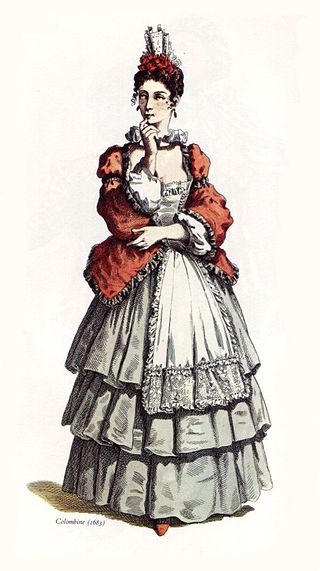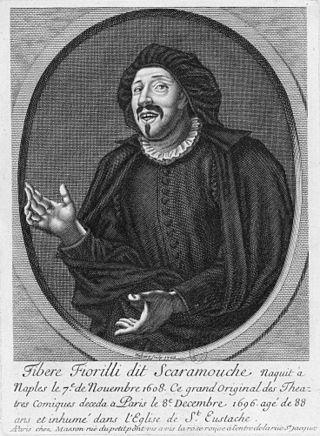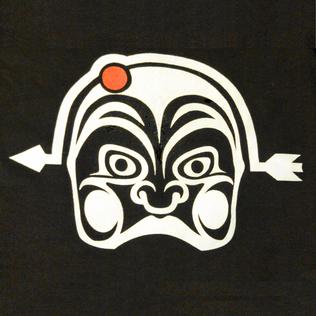
Harlequin is the best-known of the zanni or comic servant characters from the Italian commedia dell'arte, associated with the city of Bergamo. The role is traditionally believed to have been introduced by Zan Ganassa in the late 16th century, was definitively popularized by the Italian actor Tristano Martinelli in Paris in 1584–1585, and became a stock character after Martinelli's death in 1630.

Zanni, Zani or Zane is a character type of commedia dell'arte best known as an astute servant and a trickster. The Zanni comes from the countryside and is known to be a "dispossessed immigrant worker". Through time, the Zanni grew to be a popular figure who was first seen in commedia as early as the 14th century. The English word zany derives from this person. The longer the nose on the characters mask the more foolish the character.

Columbina is a stock character in the commedia dell'arte. She is Harlequin's mistress, a comic servant playing the tricky slave type, and wife of Pierrot. Rudlin and Crick use the Italian spelling Colombina in Commedia dell'arte: A Handbook for Troupes.

Gli Innamorati were stock characters within the theatre style known as commedia dell'arte, who appeared in 16th century Italy. In the plays, everything revolved around the Lovers in some regard. These dramatic and posh characters were present within commedia plays for the sole purpose of being in love with one another, and moreover, with themselves. These characters move elegantly and smoothly, and their young faces are unmasked unlike other commedia dell'arte characters. Despite facing many obstacles, the Lovers were always united by the end.
Lazzi are stock comedic routines that are associated with Commedia dell'arte. Performers, especially those playing the masked Arlecchino, had many examples of this in their repertoire, and would use improvisatory skills to weave them into the plot of dozens of different commedia scenarios. These largely physical sequences could be improvised or preplanned within the performance and were often used to enliven the audience when a scene was dragging, to cover a dropped line or cue, or to delight an expectant audience with the troupe's specialized lazzi.

Il Capitano is one of the four stock characters of Commedia dell'arte. He most likely was never a "Captain" but rather appropriated the name for himself.

Harlequinade is a British comic theatrical genre, defined by the Oxford English Dictionary as "that part of a pantomime in which the harlequin and clown play the principal parts". It developed in England between the 17th and mid-19th centuries. It was originally a slapstick adaptation or variant of the Commedia dell'arte, which originated in Italy and reached its apogee there in the 16th and 17th centuries. The story of the Harlequinade revolves around a comic incident in the lives of its five main characters: Harlequin, who loves Columbine; Columbine's greedy and foolish father Pantaloon, who tries to separate the lovers in league with the mischievous Clown; and the servant, Pierrot, usually involving chaotic chase scenes with a bumbling policeman.

Pulcinella is a classical character that originated in commedia dell'arte of the 17th century and became a stock character in Neapolitan puppetry. Pulcinella's versatility in status and attitude has captivated audiences worldwide and kept the character popular in countless forms since his introduction to commedia dell'arte by Silvio Fiorillo in 1620.

Isabella Andreini, also known as Isabella Da Padova, was an Italian actress and writer. Andreini was a member of the Compagnia dei Comici Gelosi, a touring theatre company that performed in Italy and France. The role of Isabella of the commedia dell'arte was named after her.
Zan Ganassa was the stage name of an early actor-manager of Commedia dell'arte, whose company was one of the first to tour outside Italy. Ganassa's real name was probably Alberto Naseli.

Isabella is a stock character used in commedia dell'arte, in the class of innamorata. In the commedia dell'arte, the relationship of the innamorati, or lovers, is often threatened by the vecchi characters, but they are reunited in the end. In his 1929 book The Italian Comedy, Pierre Louis Duchartre writes that Isabella changed from being mainly tender and loving in the 16th century to a more flirtatious and strong-willed woman with a "lively, picturesque wit" by the end of the 17th century.

Pedrolino is a primo zanni, or comic servant, of the Commedia dell'Arte; the name is a hypocorism of Pedro (Peter), via the suffix -lino. The character made its first appearance in the last quarter of the 16th century, apparently as the invention of the actor with whom the role was to be long identified, Giovanni Pellesini. Contemporary illustrations suggest that his white blouse and trousers constituted "a variant of the typical zanni suit", and his Bergamasque dialect marked him as a member of the "low" rustic class. But if his costume and social station were without distinction, his dramatic role was certainly not: as a multifaceted "first" zanni, his character was—and still is—rich in comic incongruities.

Tiberio Fiorilli, also spelled Fiorillo and Fiurelli was an Italian actor of commedia dell'arte known for developing the role of Scaramouche. He was especially popular in France, where he was the director of the troupe of the Comédie-Italienne, which shared with the troupe of his friend Molière at the theatre of the Petit-Bourbon, and the theatre of the Palais-Royal.

Tristano Martinelli, called Dominus Arlecchinorum, the "Master of Harlequins", was an Italian actor in the commedia dell'arte tradition. He is probably the first actor to use the name 'Harlequin' for the secondo zanni role.

Commedia dell'arte was an early form of professional theatre, originating from Italian theatre, that was popular throughout Europe between the 16th and 18th centuries. It was formerly called Italian comedy in English and is also known as commedia alla maschera, commedia improvviso, and commedia dell'arte all'improvviso. Characterized by masked "types", commedia was responsible for the rise of actresses such as Isabella Andreini and improvised performances based on sketches or scenarios. A commedia, such as The Tooth Puller, is both scripted and improvised. Characters' entrances and exits are scripted. A special characteristic of commedia is the lazzo, a joke or "something foolish or witty", usually well known to the performers and to some extent a scripted routine. Another characteristic of commedia is pantomime, which is mostly used by the character Arlecchino, now better known as Harlequin.
François Joullain (1697–1778) was a French etcher, engraver and art dealer. His career and that of his son, François-Charles Joullain, expanded from their initial roles as engravers and printmakers to merchants of paintings and publishers. He became a noted publisher for producing books of engravings which were of high quality and very popular in the 18th century and a prominent art dealer in Paris.

i Sebastiani is a Commedia dell'Arte theatre troupe formed in 1990 by Jeff Hatalsky. To the present day, i Sebastiani has performed for thousands of fans across the United States and Canada. The company has travelled as far as Montreal to the north, Miami to the south, and Texas to the west, performing more than 100 different improvisational scenarios.

Francesco Gabrielli (1588–1636) was an Italian actor of the commedia dell'arte. He was particularly famous as a virtuoso musician, who was an accomplished player of a dozen musical instruments. He is sometimes credited with the creation of Scapino, a musical zanni (servant) role, which he may actually have taken from Niccolò Barbieri. Gabrielli first appears as a member of the troupe of the Accesi in 1612, is later recorded as a member of the Confidenti, and in 1624 was with the Fedeli in Paris, before rejoining the Accesi.
Commedia dell'arte began in the 16th century. When it began, it was performed outside in piazzas, theatres, and public meeting halls and courts.

There is evidence of indoor and outdoor stages used for Commedia dell'Arte with a variation of scenic design. While we know for a fact that Commedia dell'Arte Troupes did perform in indoor spaces, there is no real evidence of use for outdoor spaces aside from depictions of various artists.
















